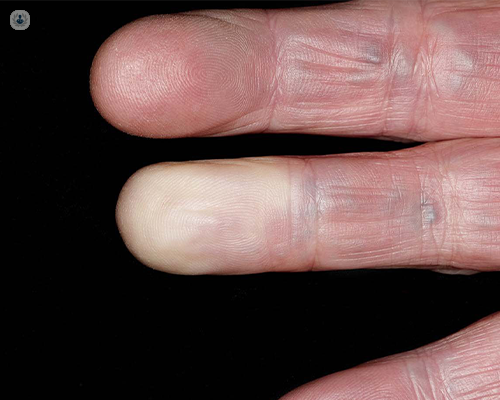What is Raynaud's disease, and how does it affect the body?
Autore:Here, Professor Tom Sheeran, a revered consultant rheumatologist, describes what Raynaud’s disease is, how it is diagnosed, and outlines the various treatment options for the condition.

What is Raynaud's disease, and how does it affect the body?
Raynaud's disease, also known as Raynaud's phenomenon or Raynaud's syndrome, is a condition characterised by episodic constriction of small blood vessels in the extremities, primarily the fingers and toes. It is classified as a vasospastic disorder, meaning that the blood vessels narrow in response to certain triggers, leading to decreased blood flow to the affected areas. This can result in colour changes in the skin (pallor, cyanosis, or redness), numbness, tingling, and pain.
The exact cause of Raynaud's disease is not fully understood, but it is believed to involve a combination of genetic and environmental factors. Abnormalities in the regulation of blood vessel diameter, such as increased sensitivity to temperature changes or emotional stress, are thought to play a role. Cold temperatures and emotional stress are the most common triggers for attacks, although other factors like smoking, certain medications, and underlying medical conditions (e.g., autoimmune diseases) can also contribute to the development or worsening of symptoms.
During an attack, the blood vessels in the affected areas constrict, reducing blood flow, causing the characteristic colour changes and associated symptoms. Once the trigger is removed or the body warms up, the blood vessels gradually dilate, and normal blood flow is restored.
How is Raynaud's disease diagnosed and what tests are performed?
The diagnosis of Raynaud's disease is primarily based on the patient's clinical history and characteristic symptoms. There is no specific test that can definitively confirm the presence of Raynaud's disease, but certain investigations are performed to rule out other potential causes and to assess the severity of the condition.
A thorough medical history is crucial, as it helps identify any underlying conditions or medications that may be contributing to the symptoms. The doctor will inquire about the frequency, duration, and triggers of Raynaud's attacks, as well as any associated symptoms or medical conditions.
Physical examination is also important and typically includes careful inspection of the affected areas. The doctor will assess the colour changes in the fingers or toes during an attack, as well as the temperature and presence of any ulcers or other skin abnormalities. Having photographs on a mobile device is an excellent way to help describe the colour changes that occur and often helps to clinch the diagnosis.
In some cases, additional tests may be recommended to exclude other possible causes or to evaluate the severity of the disease. These tests may include:
1. Nailfold capillaroscopy: This non-invasive imaging technique allows visualization of the tiny blood vessels at the base of the nail. It can help identify structural abnormalities that are often seen in connective tissue disorders associated with Raynaud's disease.
2. Blood tests: These tests may be performed to check for underlying conditions that can cause or worsen Raynaud's symptoms, such as autoimmune diseases (e.g., lupus or scleroderma), thyroid disorders, or certain infections.
3. Cold challenge test: This test involves immersing the hands or feet in cold water to induce a Raynaud's attack. By monitoring the skin temperature and blood flow in the affected areas, the severity of the condition can be assessed.
It's important to note that the diagnosis of Raynaud's disease is primarily clinical, based on the characteristic symptoms and exclusion of other causes. These diagnostic tests are mainly used to support the diagnosis and evaluate the underlying factors contributing to the condition. Remember to take photographs.
What are the common symptoms of Raynaud's disease and when should I see a doctor?
The common symptoms of Raynaud's disease include:
1. Colour changes in the affected fingers or toes: During an attack, the affected areas may turn white (pallor) due to reduced blood flow, followed by blue or purple discoloration (cyanosis) caused by tissue oxygen deprivation. As the attack subsides, the skin may turn red (rubor) due to the sudden influx of blood.
2. Numbness or tingling: Many individuals with Raynaud's disease experience a sensation of numbness or tingling in the affected fingers or toes during an attack. This occurs due to reduced nerve function resulting from the inadequate blood supply.
3. Pain or discomfort: Raynaud's attacks can be associated with pain or discomfort in the affected areas. The severity of the pain can vary from mild to intense and may persist even after the attack subsides.
It is important to see a doctor if you experience these symptoms for several reasons:
- To confirm the diagnosis of Raynaud's disease and rule out other potential causes of similar symptoms.
- To assess the severity of the condition and determine if any underlying medical conditions are contributing to the symptoms.
- To receive appropriate advice and guidance on managing the symptoms, avoiding triggers, and preventing complications.
It is essential to seek medical attention if the following signs or symptoms occur:
- Severe pain or ulceration in the affected areas
- Rapid progression of symptoms
- Presence of other concerning symptoms or medical conditions
Early intervention and proper management can help alleviate symptoms, prevent complications, and improve quality of life for individuals with Raynaud's disease.
How is Raynaud's disease treated and what are the available options?
The treatment of Raynaud's disease aims to reduce the frequency and severity of attacks, relieve symptoms, and prevent complications. The management approach typically involves a combination of non-pharmacological measures and, in some cases, medication.
Non-pharmacological measures:
1. Lifestyle modifications: avoiding triggers, such as exposure to cold temperatures and emotional stress, is crucial. Individuals with Raynaud's should dress warmly, layer clothing, and use insulated gloves and socks to protect their extremities. Stress management techniques, such as relaxation exercises, can also be helpful.
2. Warmth therapy: keeping the body and extremities warm can help prevent attacks. This may include using warm water to soak the hands or feet, wearing heated gloves or socks, or using portable hand-warming devices.
3. Regular exercise: engaging in regular physical activity can help improve blood circulation and reduce the frequency of Raynaud's attacks. Low-impact exercises, such as walking or swimming, are often recommended.
Medications:
1. Calcium channel blockers: These medications, such as nifedipine or amlodipine, are commonly prescribed to relax and widen the blood vessels, improving blood flow and reducing the frequency and severity of attacks.
2. Other vasodilators: In certain cases, other medications such as prostaglandin analogues eg iloprost, or endothelin receptor antagonists eg bosentan. may be prescribed.
3. More recently, phosphodiesterase inhibitors eg sildenafil (known as viagra) have been shown to be excellent in the management of Raynauds and also have a significant role to play in patients with pulmonary hypertension.
4. Topical nitroglycerin: Nitroglycerin ointment or patches applied to the affected areas can help dilate the blood vessels and improve blood circulation.
5. The use of Botox injections have been helpful in patients with critical ischaemia (ie severe Raynauds) but it is painful to administer.
To book a consultation with Professor Tom Sheeran today, simply visit his Top Doctors profile today.


